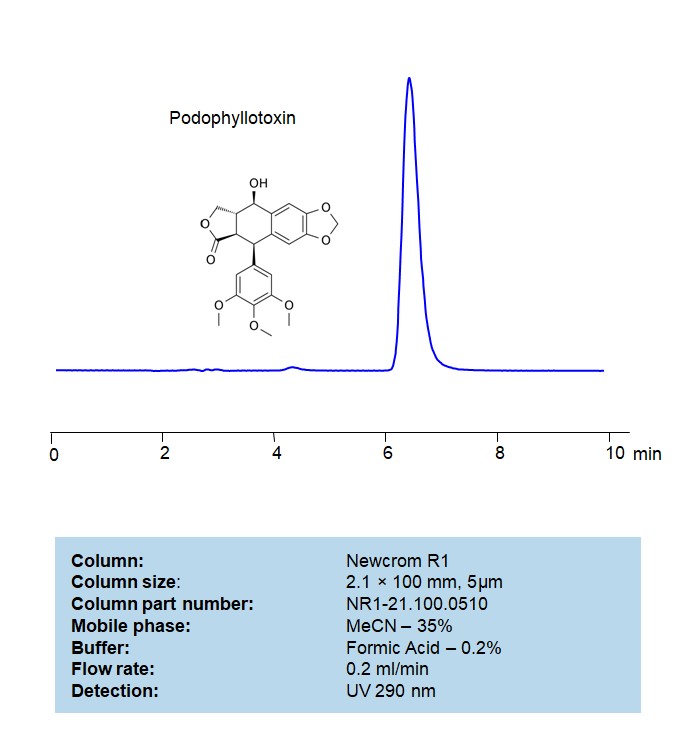HPLC Method for Analysis of Podophyllotoxin on Newcrom R1 by SIELC Technologies

High Performance Liquid Chromatography (HPLC) Method for Analysis of Podophyllotoxin
Podophyllotoxin is a non-alkaloid toxin lignan extracted from the roots and rhizomes of Podophyllum species. This compound has been used both in traditional medicine and in modern medicine for its various properties, especially its action against certain skin conditions.
Medical Uses:
Topical Treatment: Podophyllotoxin is used topically (on the skin) to treat genital warts, which are caused by the human papillomavirus (HPV). It’s found in several over-the-counter preparations, often as a solution or cream.
Anti-Cancer Activity: Podophyllotoxin is a precursor to several semi-synthetic compounds used in chemotherapy. Two of the most well-known drugs derived from podophyllotoxin are etoposide and teniposide. They are used to treat a variety of malignancies.
Mechanism of Action:
Action on Warts: It’s believed that podophyllotoxin exerts its effect on warts by causing local irritation and stimulating the immune system to clear the HPV virus.
Anti-Cancer Activity: In cancer treatment, compounds derived from podophyllotoxin work by inhibiting the enzyme topoisomerase II, which is necessary for DNA replication. By doing so, they prevent cancer cells from dividing and growing.
Ingestion: Podophyllotoxin is toxic when ingested, and internal use can cause severe systemic effects.
Conclusion:
Podophyllotoxin has valuable medical applications, from treating genital warts to serving as a base for powerful chemotherapy drugs. As with any medication or compound, it’s essential to use it correctly and under the guidance of a healthcare provider to maximize benefits and minimize potential risks.
Podophyllotoxin can be retained, separated and analyzed on a Newcrom R1 reverse phase stationary phase column using an isocratic analytical method with a simple mobile phase of water, Acetonitrile (MeCN), and a formic acid as a buffer. This analysis method can be detected using UV at 390 nm, an Evaporative Light Scattering Detector (ELSD), or any other evaporative detection method (CAD, ESI-MS)
| Column | Newcrom R1, 2.1 x 100 mm, 5 µm, 100 A, dual ended |
| Mobile Phase | MeCN – 35%, |
| Buffer | Formic Acid – 0.2% |
| Flow Rate | 0.2 ml/min |
| Detection | UV 290 nm |
| Class of Compounds | alkaloid |
| Analyzing Compounds | Podophyllotoxin |
Application Column
Newcrom R1
Column Diameter: 2.1 mm
Column Length: 100 mm
Particle Size: 5 µm
Pore Size: 100 A
Column options: dual ended





